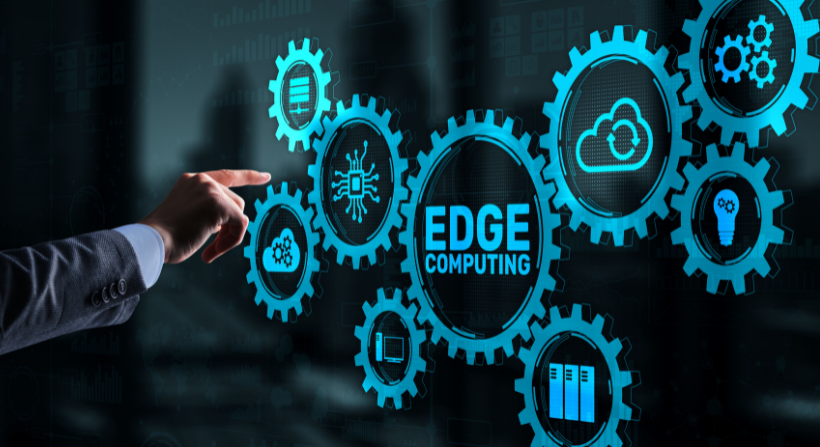As businesses struggle with the challenges of managing expanding technology stacks during the IoT boom, Statista forecasts a substantial surge in IoT devices from 15.1 billion in 2020 to over 29 billion by 2030.
Source: Global IoT connected devices: 2019 – 2023 (in billions), with forecasts extending to 2030.
In response to these dynamics, the emergence of edge computing solutions becomes crucial, providing a transformative alternative to traditional cloud computing.
Edge Computing is a solution designed to handle the surge in latency-sensitive applications associated with IoT devices. By delivering networking, computation, and storage services nearby, it effectively lowers latency delays while addressing security and privacy concerns.
This article explores how edge computing solutions can enhance network performance and offer distinct advantages over the traditional centralized cloud storage approach.
- Key Components of Edge Computing and How They Optimize Network Performance
- Advantages of Edge Computing Solutions
- Top Five Security Challenges in Edge Computing and Their Solutions
- Diverse Applications of Edge Computing Solutions
- Revolutionizing Edge Connectivity With ZirkelTech's Integrated IoT Solutions
Key Components of Edge Computing and How They Optimize Network Performance
Edge computing operates with three essential components, each playing a crucial role in shaping the edge infrastructure.
- IoT Integration: The widespread use of IoT devices has surged, creating substantial data bandwidth challenges. Edge computing thrives in an IoT environment, providing efficient programming for rapid data response and boosting benefits in terms of cost, efficiency, and connectivity.
- Communication Networks: The convergence of edge computing and 5G networks revolutionizes data management. By keeping data close to the source, edge computing complements 5G’s high-speed capabilities, reducing network load, ensuring data security, and enhancing user experiences for various applications.
- Cloud Computing: Distinguishing itself from centralized cloud computing, edge computing serves applications and devices requiring quick responses, real-time data processing, and actionable insights. It complements the cloud model by distributing computing resources closer to the point of data generation.
Advantages of Edge Computing Solutions
The widespread adoption of edge computing brings invaluable advantages for enterprise growth. According to IBM, there’s an anticipated surge, with 75% of enterprise data set to be processed at the edge by 2025, a substantial increase from the current 10%.
Some key advantages include:
- Local Data Processing: Enables faster processing times and reduces internet data transmission by processing IoT-generated data locally.
- Reduced Latency: Significantly minimizes latency for real-time or near-real-time responses in applications like self-driving cars and industrial machines.
- Bandwidth Savings: Saves on bandwidth costs by locally processing data and transmitting only essential information to the cloud, particularly beneficial for handling substantial IoT data volumes.
- Increased Security: Enhances security by locally processing data, reducing the risk of unauthorized access—critical for handling sensitive or critical IoT-generated data.
- Scalability: Addresses the challenge of managing and processing escalating IoT application numbers and data volumes by distributing the load across edge nodes and the cloud, ensuring efficient scalability and data management.
Also Read: From Sci-Fi to Reality: Advancements in AI Technology
Top Five Security Challenges in Edge Computing and Their Solutions
Let’s discuss some of the security and privacy hurdles in edge computing:
1. Data Security
Edge computing, processing data at nodes or devices, faces security challenges due to potential unauthorized access. Lower security measures compared to centralized cloud servers intensify this risk.
The solution lies in encrypting data before transmission, securing the transfer process. This proactive approach ensures secure data handling, mitigating concerns of unauthorized access in edge computing scenarios.
2. Device Vulnerability
IoT applications at the edge are susceptible to physical attacks, tampering, and unauthorized access, complicated by limited computational resources.
The way to solve this is by implementing secure communication protocols, robust authentication mechanisms, and regular software updates. This ensures a resilient defense against potential threats in edge computing environments.
3. Risk in Data Transmission
Another challenge lies in the vulnerability of data transmission between devices, nodes, and the cloud. The risk of interception jeopardizes sensitive data exposure.
To tackle this, employing secure communication protocols, encryption, and intrusion detection systems is imperative.
Moreover, solutions like TLS also secure the integrity and confidentiality of data during transmission, mitigating the potential threats associated with data exposure.
4. Privacy Implications of Local Data Processing
The local processing of data on edge nodes or devices introduces privacy challenges, especially regarding sensitive information.
Addressing these concerns involves implementing data anonymization practices alongside secure communication protocols.
This dual approach ensures responsible data handling in edge computing environments, maintaining the confidentiality of sensitive and personally identifiable information.
5. Scalability Challenges in Implementing Security Measures:
Managing and updating security measures across the expanding array of devices and edge nodes presents a significant challenge.
Addressing this involves regular software updates and robust authentication mechanisms, enhancing scalability.
This ensures the efficient management and protection of a burgeoning edge computing ecosystem, providing a secure foundation for continued growth.
Adopting the integrated security approach, encompassing devices, networks, and the cloud, is crucial. Combining various techniques and best practices effectively tackles security and privacy challenges in edge computing.
Diverse Applications of Edge Computing Solutions
Edge computing solutions find widespread implementation across various sectors, contributing to enhanced efficiency and real-time capabilities. Some notable applications include:
- Smart Cities: Edge Computing enhances traffic management and reduces congestion through real-time data processing from sensors and cameras.
- Industrial IoT: This technology optimizes production processes and minimizes downtime by providing real-time monitoring and control of machines.
- Healthcare: Edge Computing transforms healthcare delivery by enabling real-time analysis of health data for early detection, remote monitoring, and personalized treatment plans.
- Retail: It elevates customer experiences through real-time analytics for store layout optimization, inventory management, and enhanced customer interactions.
- Autonomous Vehicles: It ensures the safe and efficient operation of autonomous vehicles by processing real-time data from cameras and sensors.
These instances demonstrate the versatility and impact of edge computing solutions across diverse domains.
Revolutionizing Edge Connectivity With ZirkelTech’s Integrated IoT Solutions
In the era where edge computing is honored as the future of digital evolution, ZirkelTech emerges as a key player, leveraging the potential of this transformative paradigm. Their commitment to crafting secure, scalable, and innovative technical applications establishes them as a steadfast co-creation partner.
Across domains of AI-driven enterprise transformation, mobility solutions, Internet of Things (IoT), and Cloud/DevOps, ZirkelTech contributes significantly to the dynamic landscape of edge computing solutions.
Our seamless integration with diverse work teams ensures projects are delivered promptly and within budget.
Contact ZirkelTech today to experience the synergy of cutting-edge applications and swift, secure edge computing solutions.






